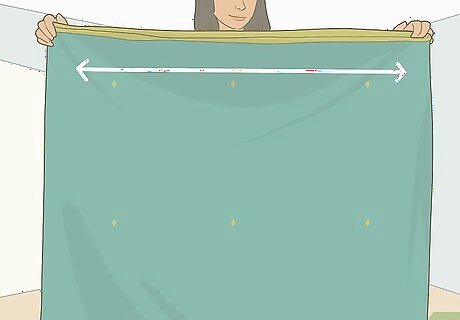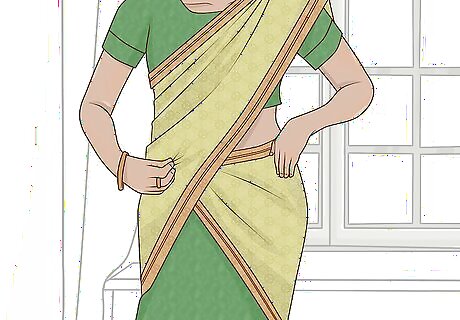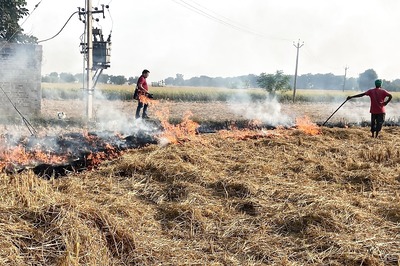
views
Characteristics of a Pure Kanjivaram Silk Saree

Kanjivaram silk sarees are handwoven from pure mulberry silk. Kanjivaram sarees are made from heavy silk and adorned with bright colors. Each saree is handwoven by a silk weaver, so no two are exactly alike. The quality fabric, intricate embroidery, and handwoven patterns make Kanjivaram sarees highly sought after and replicated. When making a Kanjivaram saree, the mulberry silk is dipped in rice water, and the zari is entwined with silver thread then dipped in 22-carat gold.
They’re notably heavier than other sarees. Kanjivaram sarees are made of strong, durable fabric. Silk threads are twisted with silver wire to create the garment, and they can weigh up to 2 kilos. In general, the pallu, or the sash, should feel heavier than the rest of the saree.
They have a distinct, feathery texture. Pure silk sarees are known to be extremely soft to the touch. The fabric may feel a bit feathery or grainy, but it should never feel rough. It should feel smooth when you run your hand over it.
Kanjivaram sarees are vibrant and shiny. Most Kanjivaram sarees are made of bold, contrasting colors, typically between the saree body and the pallu. The zari, or embroidery, has a distinct sheen, and the saree shines under direct light. These sarees also feature a pitni, which is a zigzag pattern that joins the pallu with the border. The pallu usually features a different design from the rest of the saree. Kanjivaram sarees frequently come in crimson red, emerald green, and royal blue. While Kanjivaram sarees feature metallic zari, the garments are resistant to tarnishing.
Kanjivaram sarees feature intricate zari work. Zari is a metallic thread, usually gold or silver, embroidered into the saree to create elaborate patterns and motifs. The zari of Kanjivaram sarees often feature traditional designs inspired by temple art and nature. These sarees often feature motifs like peacocks, elephants, and flowers.
Tests to Identify a Kanjivaram Silk Saree

Look for the Silk Mark symbol. The Silk Mark Organization of India is a government agency that certifies textiles are made of pure silk. True Kanjivaram silk sarees should have the symbol (which resembles a butterfly) somewhere on them. Depending on when the saree was made, the Silk Mark may be woven on a tag or on the garment itself.
Scratch the zari and look for red thread. Zari is the gold thread that adorns the saree. Gently scratch it with your fingernail and look at the threads underneath. Authentic Kanjivaram sarees will have red thread beneath the zari, while fakes often have white thread.
Rub the saree against your palm to determine softness. Pure mulberry silk has a softer texture than other silks, and Kanjivaram sarees have a smooth, glossy finish. If your saree is authentic, you’ll feel its softness and it should feel warmer than your palm. If the fabric feels rough and you don’t notice a change in temperature, it’s likely a fake.
Examine the saree in sunlight to see if it shines. Kanjivaram silk sarees have a natural sheen that isn’t found in other silks. In direct sunlight, look at your saree from all angles. You should notice a bright shine if it’s authentic. Fake Kanjivaram sarees will appear dull even in the brightest sunlight.
Slide the saree through a ring to see if the silk is smooth. Mulberry silk is naturally smooth, so a true Kanjivaram silk saree should be able to slide through a ring easily. Take a standard ring (like a wedding ring) and try to pass the entire saree through it. If it slides through easily, it’s likely authentic. If there’s a lot of resistance or you can’t get the entire saree through, it’s probably fake.
Look for a handwoven pattern rather than perfectly even threads. Pure Kanjivaram sarees are handwoven, so when you examine them closely, the pattern will be slightly uneven. Fake Kanjivaram sarees, on the other hand, are typically made with a power loom and are perfectly woven. True, handwoven Kanjivaram sarees will also be smooth on the inside of the fabric, unlike fake ones.
Check for high-quality edges, pallu, and threads. It’s important to examine the overall quality of a saree to ensure it will last for years to come. True Kanjivaram sarees will have finished edges and few to no loose threads. The pallu, or shawl, should be the same high quality as the rest of the saree.
Burn a few loose threads and smell the smoke. Known as the burn test, this is an old and reliable way to determine if silk is genuine. Carefully cut off a few loose threads from your saree, roll them up, and light them on fire. If the smoke smells like sulfur, it’s likely your saree is made of genuine silk. The presence of ashes is also a good indication.
Tips for Buying an Authentic Kanjivaram Saree

Buy from a reputable seller. One of the easiest ways to ensure you’re purchasing an authentic Kanjivaram silk saree is to research sellers. Look for stores in your area or online that have a long history of selling quality products. Some reputable saree sellers include Thriya Silks, Janardhana Silk House, and Tulsi Silks.
Ask questions about the sarees. If you’re unsure about anything while shopping for sarees, ask the retailer. A reputable seller will be more than willing to answer any questions you have, while someone might be a bit hesitant if they’re trying to sell you a counterfeit. Ask about where the saree was made, what fabric and threads were used, and if it comes with a Silk Mark certification.
Expect a true Kanjivaram saree to be expensive. Because each piece is handwoven and unique, pure Kanjivaram silk sarees tend to be on the expensive side, with some costing over $1000 USD. While some may be a bit cheaper depending on the design, if the price sounds too good to be true, it probably is. Do some research on the type of saree you’re looking for so you know the price range.

Don’t rush into buying. It may take some time to find the perfect saree for you. Buying a Kanjivaram saree is an investment, and you’ll want it to last for many years to come. Make sure the one you ultimately pick is high quality, fashionable, and something you can see yourself wearing for numerous occasions. Don’t let anyone pressure you into buying one you’re not sure about.




















Comments
0 comment